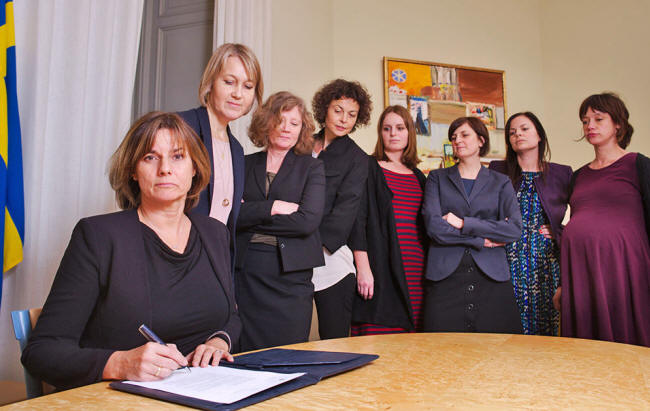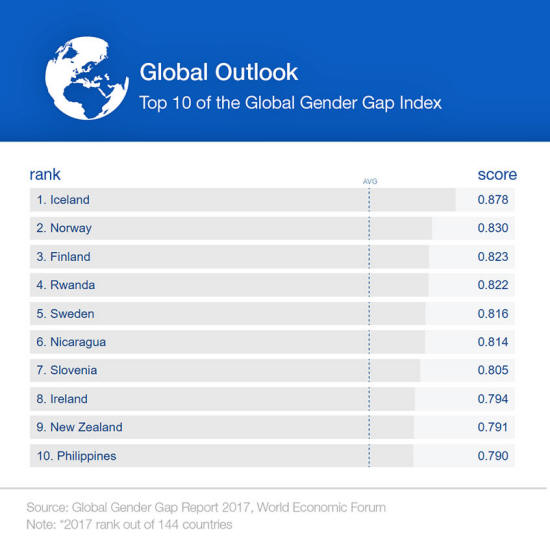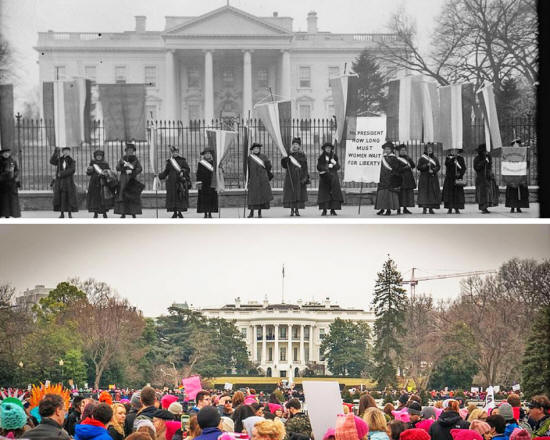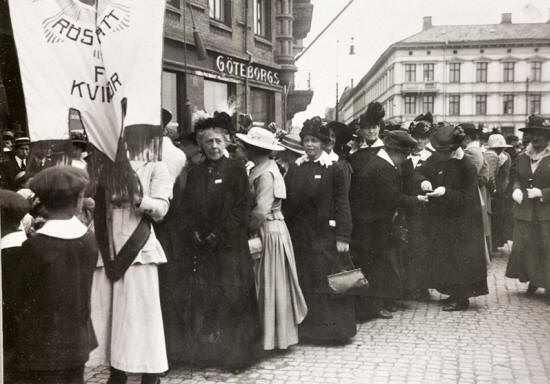|

by Victoria Martínez
May 21, 2018
from
ABitOfHistoryBlog Website

Deputy Prime Minister Isabella Lovin (L)
and
other members of Sweden's self-proclaimed feminist government
in
Stockholm on February 1, 2017.
Photo
by Johan Schiff, Regeringen/AFP/Getty
When
patriarchy and feminism joined forces,
it put Sweden on
the path to becoming
one of the most
gender-equal countries
in the world...
Sweden's history provides insight into how it
has quietly established itself as one of the
most gender equal countries in the world, while
the United States continues to loudly squabble
over legislation guaranteeing equal legal rights
regardless of gender.
While the word "feminism" can be divisive in many parts of the
world, in Sweden it has been intimately paired with the country's
government since 2014.
That year, Sweden's new
prime minister, Stefan Löfven, declared that the country
would have the world's first feminist government.
A look at the official
government website reveals statements like:
"Women and men must
have the same power to shape society and their own lives. This
is a human right and a matter of democracy and justice."
Meanwhile, in the United
States, the statement at the crux of the Equal Rights Amendment,
"Equality of rights
under the law shall not be denied or abridged by the United
States or by any state on account of sex," is still too much for
some.
Even in 2018, almost a
century after the amendment was introduced by Alice Paul, it
still doesn't have enough support for ratification.
How is it that a country with a history of high-profile women's
rights movements has been outpaced in gender equality by a small
Nordic country with comparatively quiet women's rights movements?
Before addressing this question, it's important to note that
characterizations of Sweden as some sort of feminist utopia are not
only wide of the mark, they also make the country the target of much
abuse by critics who wish to find fault with equal rights
initiatives.
Prime Minister Löfven
himself has acknowledged that "gender equality is still a distant
goal" in Sweden and the rest of the world, and this is the reason
why a feminist government is necessary.
It bears pointing out as
well that Sweden still faces challenges in regard to other forms of
equality.
Sweden, therefore, does not stand as "the" model which all other
nations and governments should follow in terms of gender and other
forms of equality. It is neither a utopia nor a representative
example of the "right" way to create a more equal society.
Still, the fact that it
has consistently ranked at the top of global equality rankings for
many years makes it an excellent case study for anyone concerned
with gender equality.

It is also important to note that Sweden has dropped slightly in the
World Economic Forum's Global Gender Gap Index since Löfven and the
feminist government took power:
from fourth place in
2014 to fifth place in 2017.
To be fair, however,
in
2014, the United States ranked 20th on the global scale.
By 2017, it had plummeted to 49th place...
Any backsliding is cause
for concern, so the situation in the U.S. is especially alarming.
That said, the intention of this essay is not to disparage
the
United States and idealize Sweden, but rather to contrast the
high-profile history of feminism and gender-equality reforms in the
U.S. with that of Sweden, which is little known outside Europe or
even Scandinavia.
This juxtaposition also
has the potential to provide valuable insight in the spirit of the
following statement by American sociologist Diane Rothbard
Margolis:
"If women around the
world are to hold on to the tentative advances already made
toward equality and build upon them, it will be because
differing movements around the world accept, respect, and learn
from their heterogeneity." 1
Diverging
Feminist Paths
The "first wave" women's movements of Sweden and the United States
followed roughly the same trajectory from the mid-19th century to
the 1920s, despite certain differences.
A key driver of both
movements was women's suffrage, accompanied by other fundamental
legal and political rights particular to each nation.
-
Women in both
countries successfully secured some of these rights around the same
time.
-
Women's suffrage, for instance, was granted to Swedish women in
1919, and to American women in 1920.
-
Women in both countries were
securing a few seats in government around this time as well. In the
U.S., Jeannette Rankin of Montana became the first woman elected to
Congress in 1916.
-
In 1922, Rebecca
Felton of Georgia became the first woman in the U.S. Senate.
-
In Sweden, 1921 - the
first year women were able to exercise their right to vote - saw
five women elected to Parliament, including Kerstin Hesselgren,
who was elected to the upper house, Elisabeth Tamm, and
Nelly Thüring.

Kerstin Hesselgren,
the
first woman elected to the Upper House
of
Sweden's Parliament, pictured circa 1925.
Creative Commons/Public Domain.
But with the vote secured and political representation a possibility
(if not always an attainable reality), the paths of the two
countries began to diverge as their respective women's movements
continued to push for additional reforms.
Notably, Swedish women
gained increasing legal equality with the full support of the
government while American women achieved success slowly, sparingly
and, often, grudgingly.
By the time Alice Paul introduced what became known as the Equal
Rights Amendment in the U.S. in 1923 (which has yet to be ratified
in 2018), Swedish women had already gained legal marital equality
2
and the right to enter into most professions. 3
In 1938, Sweden legalized
birth control and liberalized/legalized abortion. 4 By contrast, in
the U.S., birth control wasn't legalized until 1965, followed by
abortion in 1973.
Four weeks of unpaid maternity leave had already been granted to
Swedish women in 1901, and this was extended to three months of
job-protected leave in 1937, and to six months in 1945.
Paid
maternity leave was introduced in 1955 and expanded eight years
later, when it was paid at 80 percent of earnings for six months.
5 In 1974, the benefit was
extended to fathers as well and became known as parental leave.
6
Protections in the workplace also came early in Sweden compared to
the U.S., with a law protecting women from losing their jobs because
of engagement and marriage in 1939, and because of pregnancy in
1946.
These reforms arrived in the U.S. in 1964 and 1978,
respectively, although enforcement was - and still is -
problematic, often coming only after legal battles. 7

Women's rights protests in front of the White House,
Washington,
D.C., in 1917
(top, Harris & Ewing, W. Pennsylvania on the Picket
Line.
United States Washington D.C, Retried from the Library of
Congress)
and 2017 (bottom, photo by Andrew Caballero-Reynolds/AFP/Getty)
Nearly all of these reforms have since been further updated and
liberalized by the Swedish government to meet the nation's changing
needs and societal demands, not to mention the latest waves of
feminism.
The result is that not only is Sweden years ahead of the
United States in terms of gender equality, it is also benefiting
from normalization of gender-equality initiatives and forward
momentum.
An Alliance With Patriarchal Politics
Just as today's government in Sweden has (more or less) united the
goals of the nation with the goals of feminism, the same was true in
the early decades of the 20th century.
This unity was key to the
country's early progress in the march toward gender equality.
Then, as now, the Social Democrats were at the head of government.
The goals of the party and the dominant women's rights groups being
generally in agreement, and each party in need of the other's
support, the two groups,
"helped each other in an effort to cast off
the weight of industrialization and make Moder Svea (Mother Sweden)
a harmonious country which would promote the ideas of democracy,
humanitarianism and social equality". 8
Despite the fact that Sweden was still very much a patriarchal
society, historian Sondra R. Herman noted in 1972 that,
"the Swedish
tradition of patriarchal and active government has been the largest
factor in women's drive for equality", up to that time. 9
In seeking solutions for
some of the major issues of the 1920s to 1960s, such as low
population and birth rates, labor shortages, and class conflict, the
government found solutions in granting women greater rights and
freedoms.
Although these reforms obviously benefited women, they weren't done
strictly for the benefit of women, but for their impact on the
greater social and economic good of the country.
Scholar Paulina de
los Reyes has noted:
"The struggle for
equal civil rights, rather than for specific rights for women,
thus became an important ideological position in order not only
to increase the political representation of women but also to
preserve a united movement." 10
The women's rights activists, or at least those with the greatest
voice, also supported this egalitarian approach, embracing,
"all the
complexities - the relations between men and women, parents and
children, and family and state."
The result was that,
"Eventually
the transformation of the state became the overriding purpose of
feminism" in Sweden. 11

Demonstration for women's suffrage
in Gothenburg, Sweden, 1918.
Creative Commons/Public Domain,
Through this process,
"feminists became participants in complex unfoldings of multiple conflicts,"
12 and gained greater control over
their bodies and lives.
The government, for its part, was able to
maintain a traditional patriarchal order while also resolving many
of Sweden's greatest social and economic challenges in the first
half of the 20th century.
Modern scholars are right to critique and analyze the flaws of this
alliance.
But even allowing for the fact that it was not without
fault, the union of Sweden's feminists and patriarchal government
was critical,
"to the creation of a broadly egalitarian society, and
to the resolution of a range of contemporary social problems in
Sweden". 13
By the time the second wave of feminism arrived in both Sweden and
the United States in the 1960s, Sweden was far better prepared to
confront gender inequalities.
History repeated itself as Sweden
moved forward on progressive legislation beneficial to gender
equality, while American gender politics created the kind of
divisions that continue to prevent ratification of the Equal Rights
Amendment.
In Sweden today, there is general agreement that much progress has
yet to be made in terms of gender equality.
But it is this
recognition, coupled with the country's historical willingness to
make gender-equality initiatives an integral part of improving
society, that will undoubtedly continue to drive the country
forward, toward a more equal society for all.
References
-
Margolis,
Diane Rothbard. "Women’s Movements
around the World: Cross-Cultural
Comparisons."
Gender
and Society, vol. 7, no. 3, 1993,
p. 396.
-
For more
on Swedish marriage law reform: "Gender
Equality and the Welfare state. Debates
on Marriage Law Reform in Sweden at the
Beginning of the 20th Century,"
Christina Carlsson Wetterberg, 2013.
-
Some
military and clerical positions were
still excluded.
-
Abortion
was further liberalized in Sweden in
1974.
-
For
further information, see page 22 of the
PDF, "Parental
leave entitlements: Historical
perspective (around 1870-2014)."
-
Today,
parents in Sweden can divide 480 days of
paid leave between them. In the United
States,
The Family and
Medical Leave Act (FMLA)
provides "certain employees"
up to
12 weeks (480
hours)
of unpaid leave per year.
-
For
instance, a series of court cases
involving
flight attendants
in the 1960s, and a variety of
more recent cases.
-
Lindholm,
Marika. "Swedish Feminism, 1835-1945: A
Conservative Revolution."
Journal
of Historical Sociology, vol. 4,
1991, pp. 138-9.
-
Herman,
Sondra R. "Sex-Roles and Sexual
Attitudes in Sweden: The New Phase."
The
Massachusetts Review, vol. 13, no.
1/2, 1972, p. 46.
-
de los
Reyes, Paulina. "When feminism became
gender equality and anti-racism turned
into diversity management." Challenging
the myth of gender equality in Sweden.
Bristol: Policy Press, 2016, pp. 27-28.
-
Herman 50
-
Lindholm
139
-
Bradley,
David. "Perspectives on Sexual Equality
in Sweden."
The
Modern Law Review, vol. 53, no. 3,
1990, p. 300.
|






